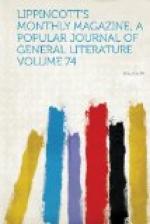“And who and what is Nanni Silvani?” asked my companion when I had categorically answered his question by stating the name of the rider whose salutation I had returned.
“Nanni—or, more correctly, Signor Giovanni—Silvani is a buttero of the Roman Campagna,” said I.
“And, pray, what may a ‘buttero’ be?” rejoined my Johnny Newcome, looking back after the receding figure of the horseman with no little curiosity.
“A buttero,” I answered, “is one of the most peculiar and characteristic products of that very peculiar region, the Agro Romano.”
The conditions under which the district around Rome is cultivated—or rather possessed and left uncultivated—are entirely sui generis—quite unlike anything else in the world. The vast undulating plain called the Campagna is divided among very few proprietors in comparison to its extent, who hold immense estates, which are more profitable than the appearance of the country, smitten to all seeming with a curse of desolation, would lead a stranger to suppose. These huge properties are held mainly by the great Roman papal families and by monastic corporations whose monasteries are within the city. In either case the property is practically inalienable, and has been passed from father to son for generations, or held by an undying religious corporation in unchanging sameness for many generations. Cultivation in the proper sense of the word is out of the question in this region: the prevalence of the deadly malaria renders it impossible. But the vast extent of the plain is wandered over by large herds of half-wild cattle, in great part buffaloes, the produce of which is turned to profit in large dairy and cheese-making establishments, and by large droves of horses, from which a very useful breed of animals is raised. The superintendence and care of these is the work of the buttero. Large flocks of sheep and goats also are fed upon the herbage of the Campagna.




